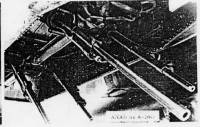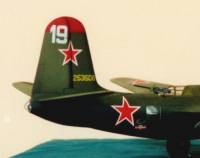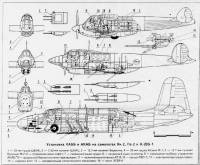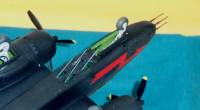A-20G-1 Night FighterBy Micheal Leduc |
 My
impetus for this project was discovered in the short history of the A-20G presented
in the instruction sheet for the first AMT A-20 I built after getting back into
the hobby a few years ago. The blurb mentioned that the kit included 20mm cannon
parts for building an "early" G and went on to state that these were
unpopular with the USAAF and were so sent to Russia Via the Lend-Lease arrangement.
Intrigued by the possibility of building something unique, thus the seed was
planted. For the next couple of years I hunted for information on these "unwanted"
aircraft with little success. The only information I could find was a fairly
common photo of a cluster of aircraft awaiting ferrying at Ladd Field in Alaska.
These were in standard Olive Drab over Neutral Grey factory camouflage and the
only distinguishing feature earmarking them for Soviet use was that the U.S.
National insignia were over painted with red stars. Not very enticing. What
I wanted to model was an aircraft in frontline service and this proved difficulty
to locate. After posting a few help requests online, info arrived from Alex
Ruchkovsky in Latvia (thanks again Alex) and it proved to be an even more interesting
subject than I had hoped for.
My
impetus for this project was discovered in the short history of the A-20G presented
in the instruction sheet for the first AMT A-20 I built after getting back into
the hobby a few years ago. The blurb mentioned that the kit included 20mm cannon
parts for building an "early" G and went on to state that these were
unpopular with the USAAF and were so sent to Russia Via the Lend-Lease arrangement.
Intrigued by the possibility of building something unique, thus the seed was
planted. For the next couple of years I hunted for information on these "unwanted"
aircraft with little success. The only information I could find was a fairly
common photo of a cluster of aircraft awaiting ferrying at Ladd Field in Alaska.
These were in standard Olive Drab over Neutral Grey factory camouflage and the
only distinguishing feature earmarking them for Soviet use was that the U.S.
National insignia were over painted with red stars. Not very enticing. What
I wanted to model was an aircraft in frontline service and this proved difficulty
to locate. After posting a few help requests online, info arrived from Alex
Ruchkovsky in Latvia (thanks again Alex) and it proved to be an even more interesting
subject than I had hoped for.
 The
VVS, like the RAF and RAAF found the A-20 to be a versatile basic platform for
a variety of tactical uses. As with many aircraft in Russian service there were
often radical field modifications to armament or the airframe to either climatic
imperative or for use in a specific role. The most common modifications prior
to arrival of the later Martin turret equipped versions were fitting the rear
gunners position with various styles of enclosed ball turret. Another example
is my previous A-20G, one modified for torpedo bombing. Thus far the VVS Night
fighter (or "Long Range Fighter" as it was called in my reference)
is the most interesting modification I have seen aside from the RAF "Turbinlight"
experiments. Whether or not it was also a successful aircraft combat wise I
can only guess.
The
VVS, like the RAF and RAAF found the A-20 to be a versatile basic platform for
a variety of tactical uses. As with many aircraft in Russian service there were
often radical field modifications to armament or the airframe to either climatic
imperative or for use in a specific role. The most common modifications prior
to arrival of the later Martin turret equipped versions were fitting the rear
gunners position with various styles of enclosed ball turret. Another example
is my previous A-20G, one modified for torpedo bombing. Thus far the VVS Night
fighter (or "Long Range Fighter" as it was called in my reference)
is the most interesting modification I have seen aside from the RAF "Turbinlight"
experiments. Whether or not it was also a successful aircraft combat wise I
can only guess.
Installed into the bomb bay of this aircraft was a belly set of guns. Two 20 MM Cannon and Two 12.7 MM machine guns. Unlike the packs attached to the RAF Boston III Invader or the P-70, that fired straight ahead these could be swung to fire down as well.
 In
concert with the four 20 MM Cannon and the two .50 Cal machine guns in the nose
this aircraft would have an impressive weight of fire. Some of these aircraft
were fitted with radar apparatus, but this one appeared to be under control
of the rear gunner/navigator via a periscope arrangement. Perhaps a good part
of the initial sighting and aiming (pilot guiding?) was done via two large windows
cut into the sides of the fuselage.
In
concert with the four 20 MM Cannon and the two .50 Cal machine guns in the nose
this aircraft would have an impressive weight of fire. Some of these aircraft
were fitted with radar apparatus, but this one appeared to be under control
of the rear gunner/navigator via a periscope arrangement. Perhaps a good part
of the initial sighting and aiming (pilot guiding?) was done via two large windows
cut into the sides of the fuselage.
(Please Note: Aside from a few scribbled notes from Alex all of my written information was in Cyrillic so much of this is speculation based on photos and drawings. That said, anything that can clarify or illuminate me on the information I have presented would be much appreciated.)
This "swinging gun" setup appears to be have been a big part of VVS night fighter strategy-- fitted to a number of types. I can only speculate that it was learned that German bombers were somewhat vulnerable to top attack. This is just as the RAF Halifax’s and Lancasters were successfully attacked from the bottom with the Luftwaffe "Jazz Music" guns mounted onto the backs of Me110’s, Ju88’s and He219’s. This tactic may have worked so well because these two British heavy bombers did not have ventral turrets like the Liberator or Flying Fortress day bombers.
The A-20G-1 is actually more similar to the A-20C than to the later block A-20G’s. This is why you need two of the AMT kits to perform this conversion. The three main areas of difference are as follows:
 Cowlings, Intakes and Exhaust - though the profile drawing attempted
to convince me otherwise, the A-20G-1 retains the longer carburetor intakes,
exhaust system, and "clean" cowls of the A-20C. The moral of the
story…always trust photos over drawings.
Cowlings, Intakes and Exhaust - though the profile drawing attempted
to convince me otherwise, the A-20G-1 retains the longer carburetor intakes,
exhaust system, and "clean" cowls of the A-20C. The moral of the
story…always trust photos over drawings.
(As a purely editorial note I always find discussions of the "best" aircraft of WWII—invariably the P-51 or the Spitfire, as spurious arguments. It seems never to be taken into account the unique conditions of combat, climate or opponent of each theatre…just my 2 cents worth. Would the VVS have like the P-51 if they had gotten them? No doubt they would have used them, but they would probably have preferred the "A" variants over the later ones - sorry getting off track here...)
 I
think that I have enthused over the AMT kit enough in my last
article. Suffice it to say that it is very nicely detailed and a great value
for the price. I used the nose from The A-20G boxing of the kit and for the
rest, the P-70 as it is basically identical to the A-20B/C. Save for a few trouble
spots it really went together well. Many reviews of this kit have criticized
the wheels in this kit and it is true that they need work. With some sanding
down of the tread and some weathering to bring out the details they actually
can look pretty good. As with the last model I built, the plain hubcaps are
correct for this aircraft so the True Details ones with the spoked hubs are
out until I build an A-20J. In the end I basically built this one straight out
of the box except for the addition of some photo-etch seatbelts and rudder pedals.
There is some cutting of plastic on the bomb bay doors and fuselage sides as
you can see but it is relatively minor. I cut the additional windows from a
plastic soda bottle. The gun pack was cobbled together from miscellaneous spare
parts and brass tubing.
I
think that I have enthused over the AMT kit enough in my last
article. Suffice it to say that it is very nicely detailed and a great value
for the price. I used the nose from The A-20G boxing of the kit and for the
rest, the P-70 as it is basically identical to the A-20B/C. Save for a few trouble
spots it really went together well. Many reviews of this kit have criticized
the wheels in this kit and it is true that they need work. With some sanding
down of the tread and some weathering to bring out the details they actually
can look pretty good. As with the last model I built, the plain hubcaps are
correct for this aircraft so the True Details ones with the spoked hubs are
out until I build an A-20J. In the end I basically built this one straight out
of the box except for the addition of some photo-etch seatbelts and rudder pedals.
There is some cutting of plastic on the bomb bay doors and fuselage sides as
you can see but it is relatively minor. I cut the additional windows from a
plastic soda bottle. The gun pack was cobbled together from miscellaneous spare
parts and brass tubing.
 Color
scheme was USAAF Olive Drab upper surfaces over black. I used Model Master "Aircraft
Interior Black" for the lowers. Decals were cribbed from Various Aeromaster
sheets. The red arrow on the nose was hand drawn and cut out of masking tape.
I will confess that at one point I had high hopes of actually making the four
guns swing up and down and attempted to make an apparatus that joined them all
together. After breaking them several times I looked at the modeling shelf and
decided that I had about 70 other kits to build before I die so I better give
this up and forge on…
Color
scheme was USAAF Olive Drab upper surfaces over black. I used Model Master "Aircraft
Interior Black" for the lowers. Decals were cribbed from Various Aeromaster
sheets. The red arrow on the nose was hand drawn and cut out of masking tape.
I will confess that at one point I had high hopes of actually making the four
guns swing up and down and attempted to make an apparatus that joined them all
together. After breaking them several times I looked at the modeling shelf and
decided that I had about 70 other kits to build before I die so I better give
this up and forge on…
Thus ends part two of a planned three part series on VVS A-20’s. My next A-20 project—a long way down the road as will be an A-20B or C with winter distemper. I am again looking to trade for unique subject matter so if stumble across an interesting previously unseen photo you have something interesting in your archives please contact me.